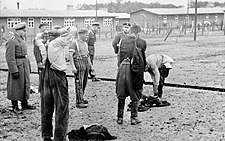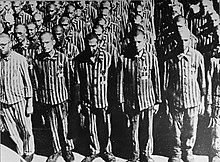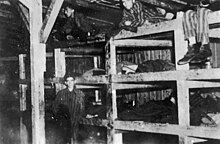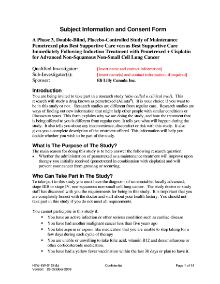| Buchenwald | |
|---|---|
| Nazi concentration camp | |
 | |
Location | Weimar, Germany |
| Operated by | Schutzstaffel |
| Commandant |
|
| Operational | 15 July 1937 – 11 April 1945 |
| Number of inmates | 280,000 |
| Killed | 56,545 |
| Liberated by | 6th Armored Division, United States Army |
| Website | www |
Buchenwald (German pronunciation: [ˈbuːxn̩valt]; literally 'beech wood') was a Nazi concentration camp established on Ettersberg hill near Weimar, Germany, in July 1937. It was one of the first and the largest of the concentration camps within Germany's 1937 borders. Many actual or suspected communists were among the first internees.
Prisoners came from all over Europe and the Soviet Union—Jews, Poles and other Slavs, the mentally ill and physically disabled, political prisoners, Romani people, Freemasons, and prisoners of war. There were also ordinary criminals and sexual "deviants". All prisoners worked primarily as forced labor in local armaments factories. The insufficient food and poor conditions, as well as deliberate executions, led to 56,545 deaths at Buchenwald of the 280,000 prisoners who passed through the camp and its 139 subcamps. The camp gained notoriety when it was liberated by the United States Army in April 1945; Allied commander Dwight D. Eisenhower visited one of its subcamps.
From August 1945 to March 1950, the camp was used by the Soviet occupation authorities as an internment camp, NKVD special camp Nr. 2, where 28,455 prisoners were held and 7,113 of whom died. Today the remains of Buchenwald serve as a memorial and permanent exhibition and museum.
Establishment
The Schutzstaffel (SS) established Buchenwald concentration camp at the beginning of July 1937. The camp was to be named Ettersberg, after the hill in Thuringia upon whose north slope the camp was established. The proposed name was deemed inappropriate, because it carried associations with several important figures in German culture, especially Enlightenment writer Johann Wolfgang von Goethe. Instead the camp was to be named Buchenwald, in reference to the beech forest in the area. However, Holocaust researcher James E. Young wrote that SS leaders chose the site of the camp precisely to erase the cultural legacy of the area. After the area of the camp was cleared of trees, only one large oak remained, supposedly one of Goethe's Oaks.
On the main gate, the motto Jedem das Seine (English: "To each his own"), was inscribed. The SS interpreted this to mean the "master race" had a right to humiliate and destroy others. It was designed by Buchenwald prisoner and Bauhaus architect Franz Ehrlich, who used a Bauhaus typeface for it, even though Bauhaus was seen as degenerate art by the National Socialists and was prohibited. This defiance however went unnoticed by the SS.
The camp, designed to hold 8,000 prisoners, was intended to replace several smaller concentration camps nearby, including Bad Sulza, Sachsenburg, and Lichtenburg. Compared to these camps, Buchenwald had a greater potential to profit the SS because the nearby clay deposits could be made into bricks by the forced labor of prisoners. The first prisoners arrived on 15 July 1937, and had to clear the area of trees and build the camp's structures. By September, the population had risen to 2,400 following transfers from Bad Sulza, Sachsenburg, and Lichtenburg.
Command structure
Organization
Buchenwald's first commandant was SS-Obersturmbannführer Karl-Otto Koch, who ran the camp from 1 August 1937 to July 1941. His second wife, Ilse Koch, became notorious as Die Hexe von Buchenwald ("the witch of Buchenwald") for her cruelty and brutality. In February 1940 Koch had an indoor riding hall built by the prisoners who died by the dozen due to the harsh conditions of the construction site. The hall was built inside the camp, near the canteen, so that oftentimes Ilse Koch could be seen riding in the morning to the beat of the prisoner orchestra. Koch himself was eventually imprisoned at Buchenwald by the Nazi authorities for incitement to murder. The charges were lodged by Prince Waldeck and Dr. Morgen, to which were later added charges of corruption, embezzlement, black market dealings, and exploitation of the camp workers for personal gain. Other camp officials were charged, including Ilse Koch. The trial resulted in Karl Koch being sentenced to death for disgracing both himself and the SS; he was executed by firing squad on 5 April 1945, one week before American troops arrived. Ilse Koch was sentenced to a term of four years' imprisonment after the war. Her sentence was reduced to two years and she was set free. She was subsequently arrested again and sentenced to life imprisonment by the post-war German authorities; she committed suicide in Aichach (Bavaria) prison in September 1967. The second commandant of the camp, between 1942 and 1945, was Hermann Pister (1942–1945). He was tried in 1947 (Dachau Trials) and sentenced to death, but on 28 September 1948 he died in Landsberg Prison of a heart attack before the sentence could be carried out.
Female prisoners and overseers
The number of women held in Buchenwald was somewhere between 500 and 1,000. The first female inmates were twenty political prisoners who were accompanied by a female SS guard (Aufseherin); these women were brought to Buchenwald from Ravensbrück in 1941 and forced into sexual slavery at the camp's brothel. The SS later fired the SS woman on duty in the brothel for corruption; her position was taken over by "brothel mothers" as ordered by SS chief Heinrich Himmler.
The majority of women prisoners, however, arrived in 1944 and 1945 from other camps, mainly Auschwitz, Ravensbrück, and Bergen Belsen. Only one barracks was set aside for them; this was overseen by the female block leader (Blockführerin) Franziska Hoengesberg, who came from Essen when it was evacuated. All the women prisoners were later shipped out to one of Buchenwald's many female satellite camps in Sömmerda, Buttelstedt, Mühlhausen, Gotha, Gelsenkirchen, Essen, Lippstadt, Weimar, Magdeburg, and Penig, to name a few. No female guards were permanently stationed at Buchenwald.
Ilse Koch served as head supervisor (Oberaufseherin) of 22 other female guards and hundreds of women prisoners in the main camp. More than 530 women served as guards in the vast Buchenwald system of subcamps and external commands across Germany. Only 22 women served/trained in Buchenwald, compared to over 15,500 men.
Subcamps
The first subcamps of Buchenwald were established in 1941 so that the prisoners could work in nearby SS industries. In 1942, the SS began to use its forced labor supply for armaments production. Because it was more economical to rent out prisoners to private firms, subcamps were set up near factories which had a demand for prisoner labor. Private firms paid the SS between 4 and 6 Reichsmarks per day per prisoner, resulting in an estimated 95,758,843 Reichsmarks in revenue for the SS between June 1943 and February 1945. There were 136 subcamps in all. Conditions were worse than at the main camp, with prisoners provided insufficient food and inadequate shelter.
Allied POWs
Although it was highly unusual for German authorities to send Western Allied POWs to concentration camps, Buchenwald held a group of 168 aviators for two months. These men were from the United States, United Kingdom, Canada, Australia, New Zealand and Jamaica. They all arrived at Buchenwald on 20 August 1944.
All these airmen were in aircraft that had crashed in occupied France. Two explanations are given for them being sent to a concentration camp: first, that they had managed to make contact with the French Resistance, some were disguised as civilians, and they were carrying false papers when caught; they were therefore categorized by the Germans as spies, which meant their rights under the Geneva Convention were not respected. The second explanation is that they had been categorised as Terrorflieger ("terror aviators"). The aviators were initially held in Gestapo prisons and headquarters in France. In April or August 1944, they and other Gestapo prisoners were packed into covered goods wagons (US: boxcars) and sent to Buchenwald. The journey took five days, during which they received very little food or water.
Death toll
Causes of death
A primary cause of death was illness due to harsh camp conditions, with starvation—and its consequent illnesses—prevalent. Malnourished and suffering from disease, many were literally "worked to death" under the Vernichtung durch Arbeit policy (extermination through labor), as inmates only had the choice between slave labor or inevitable execution. Many inmates died as a result of human experimentation or fell victim to arbitrary acts perpetrated by the SS guards. Other prisoners were simply murdered, primarily by shooting and hanging.
Walter Gerhard Martin Sommer was an SS-Hauptscharführer who served as a guard at the concentration camps of Dachau and Buchenwald. Known as the "Hangman of Buchenwald", he was considered a depraved sadist who reportedly ordered Otto Neururer and Mathias Spannlang, two Austrian priests, to be crucified upside-down. Sommer was especially infamous for hanging prisoners off of trees from their wrists, which had been tied behind their backs (a torture technique known as strappado) in the "singing forest", so named because of the screams which emanated from this wooded area.
Summary executions of Soviet POWs were also carried out at Buchenwald. At least 1,000 men were selected in 1941–42 by a task force of three Dresden Gestapo officers and sent to the camp for immediate liquidation by a gunshot to the back of the neck, the infamous Genickschuss.
The camp was also a site of large-scale trials for vaccines against epidemic typhus in 1942 and 1943. In all 729 inmates were used as test subjects, of whom 154 died. Other "experimentation" occurred at Buchenwald on a smaller scale. One such experiment aimed at determining the precise fatal dose of a poison of the alkaloid group; according to the testimony of one doctor, four Soviet POWs were administered the poison, and when it proved not to be fatal they were "strangled in the crematorium" and subsequently "dissected". Among various other experiments was one which, in order to test the effectiveness of a balm for wounds from incendiary bombs, involved inflicting "very severe" white phosphorus burns on inmates. When challenged at trial over the nature of this testing, and particularly over the fact that the testing was designed in some cases to cause death and only to measure the time which elapsed until death was caused, one Nazi doctor's defence was that, although a doctor, he was a "legally appointed executioner".
Number of deaths
The SS left behind accounts of the number of prisoners and people coming to and leaving the camp, categorizing those leaving them by release, transfer, or death. These accounts are one of the sources of estimates for the number of deaths in Buchenwald. According to SS documents, 33,462 died. These documents were not, however, necessarily accurate: Among those executed before 1944, many were listed as "transferred to the Gestapo". Furthermore, from 1941, Soviet POWs were executed in mass killings. Arriving prisoners selected for execution were not entered into the camp register and therefore were not among the 33,462 dead listed.
One former Buchenwald prisoner, Armin Walter, calculated the number of executions by the number of shootings in the spine at the base of the head. His job at Buchenwald was to set up and care for a radio installation at the facility where people were executed; he counted the numbers, which arrived by telex, and hid the information. He says that 8,483 Soviet prisoners of war were shot in this manner.
According to the same source, the total number of deaths at Buchenwald is estimated at 56,545. This number is the sum of:
- Deaths according to material left behind by the SS: 33,462
- Executions by shooting: 8,483
- Executions by hanging (estimate): 1,100
- Deaths during evacuation transports (estimate): 13,500
This total (56,545) corresponds to a death rate of 24 percent, assuming that the number of persons passing through the camp according to documents left by the SS, 240,000 prisoners, is accurate.
Liberation
On 4 April 1945 the U.S. 89th Infantry Division overran Ohrdruf, a subcamp of Buchenwald.
Buchenwald was partially evacuated by the Germans from 6 to 11 April 1945. In the days before the arrival of the American army, thousands of the prisoners were forced to join the evacuation marches. Thanks in large part to the efforts of Polish engineer (and short-wave radio-amateur, his pre-war callsign was SP2BD) Gwidon Damazyn, an inmate since March 1941, a secret short-wave transmitter and small generator were built and hidden in the prisoners' movie room. On April 8 at noon, Damazyn and Russian prisoner Konstantin Ivanovich Leonov sent the Morse code message prepared by leaders of the prisoners' underground resistance (supposedly Walter Bartel and Harry Kuhn):
To the Allies. To the army of General Patton. This is the Buchenwald concentration camp. SOS. We request help. They want to evacuate us. The SS wants to destroy us.
The text was repeated several times in English, German, and Russian. Damazyn sent the English and German transmissions, while Leonov sent the Russian version. Three minutes after the last transmission sent by Damazyn, the headquarters of the U.S. Third Army responded:
KZ Bu. Hold out. Rushing to your aid. Staff of Third Army.
According to Teofil Witek, a fellow Polish prisoner who witnessed the transmissions, Damazyn fainted after receiving the message.
After this news had been received, inmates stormed the watchtowers and killed the remaining guards, using arms they had been collecting since 1942 (one machine gun and 91 rifles; see Buchenwald Resistance).
As American forces closed in, Gestapo headquarters at Weimar telephoned the camp administration to announce that it was sending explosives to blow up any evidence of the camp, including its inmates. The Gestapo did not know that the administrators had already fled. A prisoner answered the phone and informed headquarters that explosives would not be needed, as the camp had already been blown up, which was not true.
A detachment of troops of the U.S. 9th Armored Infantry Battalion, from the 6th Armored Division, part of the U.S. Third Army, and under the command of Captain Frederic Keffer, arrived at Buchenwald on 11 April 1945 at 3:15 p.m. (now the permanent time of the clock at the entrance gate). The soldiers were given a hero's welcome, with the emaciated survivors finding the strength to toss some liberators into the air in celebration.
Later in the day, elements of the U.S. 83rd Infantry Division overran Langenstein, one of a number of smaller camps comprising the Buchenwald complex. There, the division liberated over 21,000 prisoners, ordered the mayor of Langenstein to send food and water to the camp, and hurried medical supplies forward from the 20th Field Hospital.
Third Army Headquarters sent elements of the 80th Infantry Division to take control of the camp on the morning of Thursday 12 April 1945. Several journalists arrived on the same day, perhaps with the 80th, including Edward R. Murrow, whose radio report of his arrival and reception was broadcast on CBS and became one of his most famous:
I asked to see one of the barracks. It happened to be occupied by Czechoslovaks. When I entered, men crowded around, tried to lift me to their shoulders. They were too weak. Many of them could not get out of bed. I was told that this building had once stabled 80 horses. There were 1,200 men in it, five to a bunk. The stink was beyond all description.
They called the doctor. We inspected his records. There were only names in the little black book, nothing more. Nothing about who these men were, what they had done, or hoped. Behind the names of those who had died, there was a cross. I counted them. They totaled 242. 242 out of 1,200, in one month.
As we walked out into the courtyard, a man fell dead. Two others, they must have been over 60, were crawling toward the latrine. I saw it, but will not describe it.
— Extract from Edward R. Murrow's Buchenwald Report – 15 April 1945.
Civilian tour
After Patton toured the camp, he ordered the mayor of Weimar to bring 1,000 citizens to Buchenwald; these were to be predominantly men of military age from the middle and upper classes. The Germans had to walk 25 kilometres (16 mi) roundtrip under armed American guard and were shown the crematorium and other evidence of Nazi atrocities. The Americans wanted to ensure that the German people would take responsibility for Nazi crimes, instead of dismissing them as atrocity propaganda.[38] Gen. Dwight Eisenhower also invited two groups of Americans to tour the camp in mid-April 1945; journalists and editors from some of the principal U.S. publications, and then a dozen members of the Congress from both the House and the Senate, led by Senate Majority Leader Alben W. Barkley.
Aftermath
Buchenwald Trial
Thirty SS perpetrators at Buchenwald were tried before a US military tribunal in 1947, including Higher SS and Police Leader Josias Erbprinz zu Waldeck und Pyrmont, who oversaw the SS district that Buchenwald was located in, and many of the doctors responsible for Nazi human experimentation. Almost all of the defendants were convicted, and 22 were sentenced to death. However, only nine death sentences were carried out, and by the mid-1950s, all perpetrators had been freed except for Ilse Koch. Additional perpetrators were tried before German courts during the 1960s.
The site
Between August 1945 and 1 March 1950, Buchenwald was the site of NKVD special camp Nr. 2, where the Soviet secret police imprisoned former Nazis and anti-communist dissidents. According to Soviet records, 28,455 people were detained, 7,113 of whom died. After the NKVD camp closed, much of the camp was razed, while signs were erected to provide a Soviet interpretation of the camp's legacy. The first monument to victims was erected by Buchenwald inmates days after the initial liberation. It was made of wood and only intended to be temporary. A second monument to commemorate the dead was erected in 1958 by the GDR government near the mass graves. Inside the camp, there is a stainless steel monument on the spot where the first, temporary monument stood. Its surface is maintained at 37 °C (99 °F), the temperature of human skin, all year round. Today the Buchenwald camp site serves as a Holocaust memorial. It has a museum with permanent exhibitions about the history of the camp. It is managed by Buchenwald and Mittelbau-Dora Memorials Foundation, which also looks after the camp memorial at Mittelbau-Dora.
Literature
Survivors who have written about their camp experiences include Jorge Semprún, who in Quel beau dimanche! describes conversations involving Goethe and Léon Blum, and Ernst Wiechert, whose Der Totenwald was written in 1939 but not published until 1945, and which likewise involved Goethe. Scholars have investigated how camp inmates used art to help deal with their circumstances, and according to Theodor Ziolkowski writers often did so by turning to Goethe. Artist Léon Delarbre sketched, besides other scenes of camp life, the Goethe Oak, under which he used to sit and write. One of the few prisoners who escaped from the camp, the Belgian Edmond Vandievoet, recounted his experiences in a book whose English title is "I escaped from a Nazi Death Camp" [Editions Jourdan, 2015]. In his work Night, Elie Wiesel talks about his stay in Buchenwald, including his father's death. Jacques Lusseyran, a leader in the underground resistance to the German occupation of France, was eventually sent to Buchenwald after being arrested, and described his time there in his autobiography.
Visit from President Obama and Chancellor Merkel
On June 5, 2009, U.S. President Barack Obama and German Chancellor Angela Merkel visited Buchenwald after a tour of Dresden Castle and Church of Our Lady. During the visit they were accompanied by Elie Wiesel and Bertrand Herz, both survivors of the camp. Volkhard Knigge, the director of the Buchenwald and Mittelbau-Dora Memorials Foundation and honorary professor of University of Jena, guided the four guests through the remainder of the site of the camp. During the visit Wiesel, who together with Herz were sent to the Little camp as 16-year-old boys, said, "if these trees could talk." His statement marked the irony about the beauty of the landscape and the horrors that took place within the camp. President Obama mentioned during his visit that he had heard stories as a child from his great uncle, who was part of the 89th Infantry Division, the first Americans to reach the camp at Ohrdruf, one of Buchenwald's satellites. Obama was the first sitting US President to visit the Buchenwald concentration camp.

















